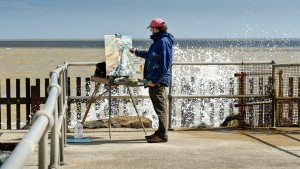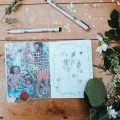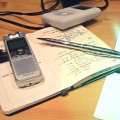Having a musical background while writing – no matter if it is a letter, a diary entry, or a fictional story – boosts creativity, concentration, and even motivation. This is quite the well-known fact (as long as the lyrics aren’t distracting the author). Yet, other creative hobbies benefit from musical background as well, such as sewing or crocheting. The actually quite large field we want to look at today though is: drawing and painting.

No matter if you are sitting in front of a blank sheet of paper, your computer monitor, or a canvas; no matter of you want to pain, sketch, draw, or illustrate; the right kind of musical background can be a real boost for your creativity. Of course, different styles, art forms, and motives require different music choices, and while we can give you some suggestions, in the end you are the only one who really knows what sustains your inspiration and makes your creative juices flow.
Usually, painting means a vertical canvas on an easel that is slowly filled by layer of layer of oil or water colors. Drawing, however, is more associated with paper and colorful pens or chalk. Sketching makes use of a basic pen and paper for quick doodles and reference sketches, while illustrating or coloring quickly make you think about computers, drawing tablets, and Photoshop. Yet, the utilities used aren’t necessarily determining the background sounds you may want to choose for your painting pleasure. Rather, it’s the theme that should determine your choice.
Landscapes
The typical themes occurring especially in paintings are landscapes, still life, and portraits. Yet, not every stunning scenery of a wild mountain lake and dark forests has been produced by wandering into the nature. Many actually took form in an atelier, either after a visit of the scenery depicted, or without having been there at all. Thus, creating a musical background with the sounds of nature can either bring you in the right mood or help you recall the landscape you saw when making your first sketches or taking a reference photograph.
Still Life and Portraits
A still life or (self) portrait however is, most commonly, made by having the object(s) right in front of you. A relaxing atmosphere is advised when working with a model that surely doesn’t want to be in stress during the painting session. Not to mention that you, as the painter or drawer benefit from soothing and relaxing sounds as well.
Modern Art
An art form where calm and relaxation seems more secondary may be modern art. A tree, a half-naked woman, a cityscape? Clear forms and motifs are rare when your creativity just wants to burst out in colors and surreal shapes! More psychedelic or even trippy sounds may be more fun and inspiring in this case, promoting and supporting your creative outburst.
Fantasy Art
Fantasy Art can either be dreamy and inspired by medieval themes, or contain a high percentage of technology and space themes. They can even feature the creatures out of your worst nightmares. For pictures filled with dragons and untouched landscape, natural sounds with a fantastical touch may be the right choice. Drawings or Illustrations that involve aliens, spaceships, and the vast space benefit from more science fiction like musical backgrounds though. Werewolves, Zombies, Nightmares, and spooky castles however, may come to live more easily when turning up the volume of some horror sounds.
Fanart
And last but not least, there is the big topic of fan-inspired art. Figures from your favorite book can become alive, the beautiful scenery of your favorite movie can be depicted on your canvas, or characters you came to love because you see them perform concerts or playing parts in TV series may become a bit more sizable. All in all, fanart is a creative and honoring way to express your awe and love for a movie, game, series, book, comic, or even for a real life person. Choosing sound mixes that were created with a certain movie or series in mind, or based on your favorite game bring you in the right mood to create some amazing pieces of fanart.



